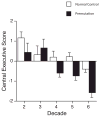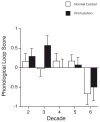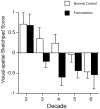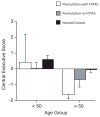Lifespan changes in working memory in fragile X premutation males
- PMID: 19114290
- PMCID: PMC4158922
- DOI: 10.1016/j.bandc.2008.11.006
Lifespan changes in working memory in fragile X premutation males
Abstract
Fragile X syndrome is the world's most common hereditary cause of developmental delay in males and is now well characterized at the biological, brain and cognitive levels. The disorder is caused by the silencing of a single gene on the X chromosome, the FMR1 gene. The premutation (carrier) status, however, is less well documented but has an emerging literature that highlights a more subtle profile of executive cognitive deficiencies that mirror those reported in fully affected males. Rarely, however, has the issue of age-related declines in cognitive performance in premutation males been addressed. In the present study, we focus specifically on the cognitive domain of working memory and its subcomponents (verbal, spatial and central executive memory) and explore performance across a broad sample of premutation males aged 18-69 years matched on age and IQ to unaffected comparison males. We further tease apart the premutation status into those males with symptoms of the newly identified neurodegenerative disorder, the fragile X-associated tremor/ataxia syndrome (FXTAS) and those males currently symptom-free. Our findings indicate a specific vulnerability in premutation males on tasks that require simultaneous manipulation and storage of new information, so-called executive control of memory. Furthermore, this vulnerability appears to exist regardless of the presence of FXTAS symptoms. Males with FXTAS symptoms demonstrated a more general impairment encompassing phonological working memory in addition to central executive working memory. Among asymptomatic premutation males, we observed the novel finding of a relationship between increased CGG repeat size and impairment to central executive working memory.
Figures




Similar articles
-
Neuropsychological findings from older premutation carrier males and their noncarrier siblings from families with fragile X syndrome.Neuropsychology. 2011 May;25(3):404-411. doi: 10.1037/a0021879. Neuropsychology. 2011. PMID: 21443343 Free PMC article.
-
An fMRI study of the prefrontal activity during the performance of a working memory task in premutation carriers of the fragile X mental retardation 1 gene with and without fragile X-associated tremor/ataxia syndrome (FXTAS).J Psychiatr Res. 2011 Jan;45(1):36-43. doi: 10.1016/j.jpsychires.2010.04.030. Epub 2010 May 31. J Psychiatr Res. 2011. PMID: 20537351 Free PMC article.
-
Mapping self-reports of working memory deficits to executive dysfunction in Fragile X Mental Retardation 1 (FMR1) gene premutation carriers asymptomatic for FXTAS.Brain Cogn. 2010 Aug;73(3):236-43. doi: 10.1016/j.bandc.2010.05.008. Epub 2010 Jun 22. Brain Cogn. 2010. PMID: 20573435
-
[FMR1 PREMUTATION CARRIERS - ARE THEY REALLY ASYMPTOMATIC?].Harefuah. 2018 Apr;157(4):241-244. Harefuah. 2018. PMID: 29688643 Review. Hebrew.
-
Fragile X-Associated Tremor/Ataxia Syndrome (FXTAS): Pathophysiology and Clinical Implications.Int J Mol Sci. 2020 Jun 20;21(12):4391. doi: 10.3390/ijms21124391. Int J Mol Sci. 2020. PMID: 32575683 Free PMC article. Review.
Cited by
-
Neuropsychological changes in FMR1 premutation carriers and onset of fragile X-associated tremor/ataxia syndrome.J Neurodev Disord. 2022 Mar 23;14(1):23. doi: 10.1186/s11689-022-09436-y. J Neurodev Disord. 2022. PMID: 35321639 Free PMC article.
-
Association between macroorchidism and intelligence in FMR1 premutation carriers.Am J Med Genet A. 2014 Sep;164A(9):2206-11. doi: 10.1002/ajmg.a.36624. Epub 2014 Jun 5. Am J Med Genet A. 2014. PMID: 24903624 Free PMC article.
-
Understanding the neuropsychiatric phenotype of fragile X-associated tremor ataxia syndrome: a systematic review.Neuropsychol Rev. 2014 Dec;24(4):491-513. doi: 10.1007/s11065-014-9262-9. Epub 2014 May 15. Neuropsychol Rev. 2014. PMID: 24828430 Review.
-
Linking the FMR1 alleles with small CGG expansions with neurodevelopmental disorders: preliminary data suggest an involvement of epigenetic mechanisms.Am J Med Genet A. 2009 Oct;149A(10):2306-10. doi: 10.1002/ajmg.a.32990. Am J Med Genet A. 2009. PMID: 19760650 Free PMC article. No abstract available.
-
A voxel-based morphometry study of grey matter loss in fragile X-associated tremor/ataxia syndrome.Brain. 2011 Mar;134(Pt 3):863-78. doi: 10.1093/brain/awq368. Brain. 2011. PMID: 21354978 Free PMC article.
References
-
- Allen EG, Sherman S, Abramowitz A, Leslie M, Novak G, Rusin M, Scott E, Letz R. Examination of the effect of the polymorphic CGG repeat in the FMR1 gene on cognitive performance. Behavioral Genetics. 2005;35:435–45. - PubMed
-
- Allingham-Hawkins DJ, Brown CA, Babul R, Chitayat D, Krekewich K, Humphries T, Ray PN, Teshima IE. Tissue-specific methylation differences and cognitive function in fragile X premutation females. American Journal of Medical Genetics. 1996;64:329–33. - PubMed
-
- Bacalman S, Farzin F, Bourgeois JA, Cogswell J, Goodlin-Jones BL, Gane LW, Grigsby J, Leehey MA, Tassone F, Hagerman RJ. Psychiatric phenotype of the fragile X-associated tremor/ataxia syndrome (FXTAS) in males: newly described fronto-subcortical dementia. Journal of Clininical Psychiatry. 2006;67:87–94. - PubMed
-
- Baddeley A. The episodic buffer: a new component of working memory? Trends in Cognitive Science. 2000;4:417–423. - PubMed
-
- Baddeley AD. Working Memory. Oxford: Oxford University Press; 1986.
Publication types
MeSH terms
Substances
Grants and funding
LinkOut - more resources
Full Text Sources
Medical

